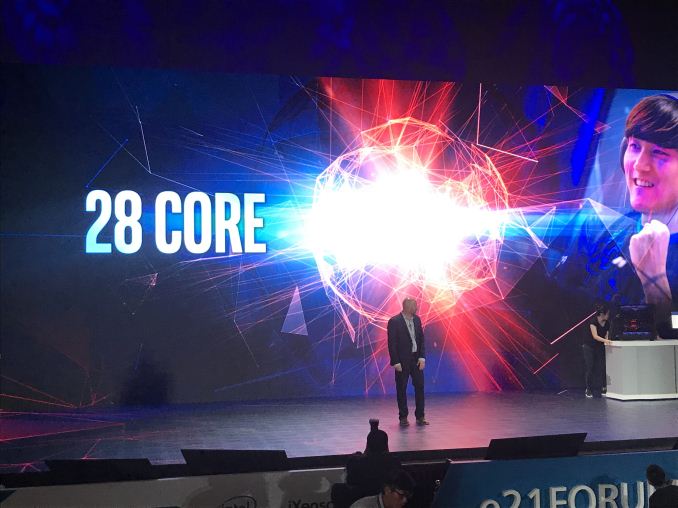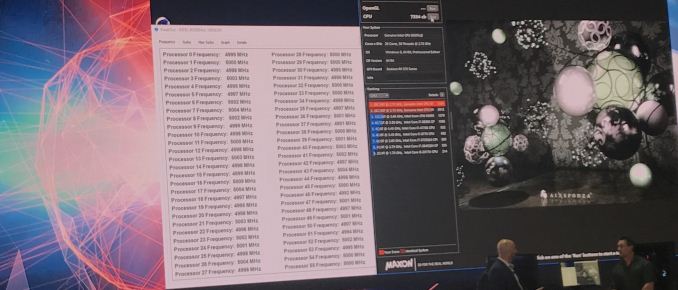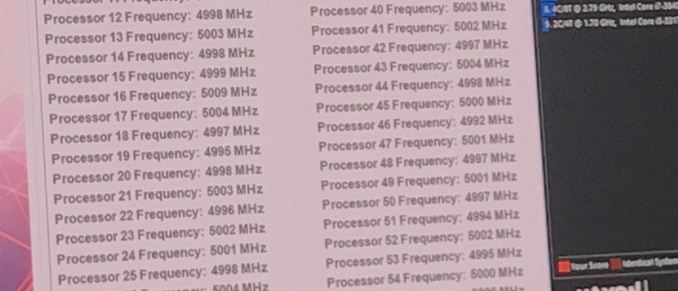Intel’s 28-Core 5 GHz CPU: Coming in Q4
by Ian Cutress on June 5, 2018 3:09 AM EST- Posted in
- CPUs
- Intel
- Trade Shows
- Computex 2018
- 28-core

Update 06/08: Intel has since backtracked on its initial statements, clarifying that while a 28-core part is coming in Q4 of this year, its stock frequency will not be 5GHz. Rather this was a (very poorly communicated) overclocking demo of the upcoming part. For more details, please see this article.
Alongside the launch of Intel’s first 5 GHz processor, the 6-core Core i7-8086K, Intel today also showcased a 28-core single socket machine also running at 5 GHz. The system on display scored 7334 in Cinebench R15, and Gregory Bryant (SVP and GM of Intel Client Computing Group) explicitly stated that it would be coming in Q4 this year.
No other details were provided, however for it to exist in a current platform, this new processor would likely be in LGA2066 (X299) or LGA3647 (the server socket). Intel technically already makes 28-core monolithic designs in the Intel Xeon Scalable Platform with the Xeon Platinum 8180, which is a $10k processor, which runs a lot slower than 5.0 GHz.
Personally, I feel this new processor is not a higher binned Platinum 8180. Going up from 2.8 GHz base / 3.5 GHz turbo to 5.0 GHz all-core frequency is a big step, assuming the 5.0 GHz value was not an overclock. I would fully expect that this is the point where Intel starts introducing EMIB to CPUs. (ed: FWIW, I disagree with Ian; my money is on a heavily binned 28-core XCC processor made on 14++. We've seen that Intel can do 5GHz on that process with the 8086K)
Last week I discussed the potential death of Intel’s low-end core design for high-end desktop, because it was being eclipsed by the mainstream parts. The only way Intel would be able to reuse the server versions of those low-core count designs would be to enable its embedded multi-die interconnect bridge (EMIB) technology to put two or more of the smaller dies on the same package. This would allow Intel do amortize costs in the same way AMD does by making use of higher yielding parts (as die size goes down, yield goes up).
Intel’s EMIB has a potentially high bi-directional bandwidth, so it would be interesting to see if Intel would bind two dies together and if there is any additional latency or bandwidth decrease with two dies together. With 28 cores, that would subdivide by two to 14-each, but not to four. So this processor is likely to be two 14-core dies using EMIB… which would actually be Intel’s HCC (high-core-count) processor design.
To add something extra to the mix, Intel might not be using EMIB at all. It could just as easily be the QPI interface on package, much how the company is using the Xeon + FPGA products announced recently.
So our primary questions to Intel would be:
- Monolithic or multi-die
- QPI or EMIB
- Socket
- Die size
- TDP / Power consumption at 5 GHz
TDP is a big part of the equation here. 28 cores at 5.0 GHz doesn’t come for free. The next questions are around price and launch date.
Additional:
There's the discussion about cutting into Intel's 1P market with such a product. But also, consider that at CES that Supermicro rated their X299 motherboards as supporting 300W processors, so it could easily correlate this processor to LGA2066 and a 300W TDP. That would be... fun... I guess?
| Want to keep up to date with all of our Computex 2018 Coverage? | ||||||
 Laptops |
 Hardware |
 Chips |
||||
| Follow AnandTech's breaking news here! | ||||||













87 Comments
View All Comments
virpuain@gmail.com - Friday, June 8, 2018 - link
I disagree. It was an overclocked engineering sample of a existing CPU. If that was not the case then why they would need a motherboard with more than 30 phases + giant HS and a freaking 1700W capable water chiller. Cmon !ChristopherFortineux - Friday, June 8, 2018 - link
I have a feeling this is already starting to haunt intel. This sort of marketing at the expense of logic is just ignorant. This is clearly a sad and pathetic attempt. Never make claims up-front that will never hold out in the future. This chip will never ship at 5GHz on all cores out of the box nor is it logical to try to persuade the public that it is attainable by most standards. There is no wonder that ThreadRipper parts are flying off the shelves over intel. This CPU will launch around 2,500 - 3,000 USD or more possibly. Who is this marketted to? Why would anyone choose this over an established Xeon or purchase the competition that is superior in core count and efficiency.B3an - Saturday, June 9, 2018 - link
Shame on AT for posting this obviously false story. The author should be fired. Can't believe you actually thought this even might be possible. This is something i'd expect from Gawker/Engadget and other "tech" site shit. Absolute disgrace.AdditionalPylons - Tuesday, June 12, 2018 - link
In my opinion, Ian is one of the most talented tech journalists out there. It's Intel that should be blamed for giving everyone false hopes by "forgetting" to mention the OC.milomilo - Saturday, June 9, 2018 - link
Why no correction on this article title ? the facts and admission from intel already state theres no 28 core with 5ghz in Q4 , then why Anandtech perisit in keeping the false title up ? AT said they are free to post article without pressure from Intel , ok then why keep this obviously false title up ? either you have no credibility as tech journalist , or you just incompetent as a journalist if you persist on the title..and no, small print updates inside the article dont wash out the obvious fake title
xpto - Thursday, June 14, 2018 - link
New Vulnerability hits Intel processors - Lazy FP State Restorehttps://www.intel.com/content/www/us/en/security-c...